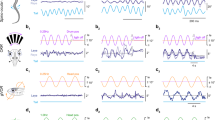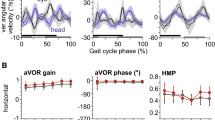Abstract
During head/body movements, gaze stability is ensured by transformation of motion-related sensory signals into respective motor commands. Passively induced motion in all vertebrates including amphibians evokes a robust vestibulo-ocular reflex, suggesting an equally important role of this motor reaction during actively induced motion. However, during self-induced movements including locomotion, motor efference copies offer a convenient additional substrate for counteracting retinal image displacements. During such locomotor activity in Xenopus laevis tadpoles, spinal central pattern generator-derived efference copies elicit spatio-temporally specific eye movements, which are functionally appropriate to offset swimming-related retinal image displacements. In addition, passively induced horizontal semicircular canal signals are suppressed, making intrinsic spino-extraocular motor coupling the dominating mechanism for gaze stabilization during locomotion. The presence of functionally appropriate efference copy-driven eye movements in adult frogs with limb-based locomotion suggests that this mechanism might play a role for gaze stability during rhythmic locomotion also in other vertebrates.


Similar content being viewed by others
References
Angelaki DE, Cullen KE (2008) Vestibular system: the many facets of a multimodal sense. Annu Rev Neurosci 31:125–150
Straka H, Dieringer N (2004) Basic organization principles of the VOR: lessons from frogs. Prog Neurobiol 73:259–309
Straka H, Zwergal A, Cullen KE (2016) Vestibular animal models: contributions to understanding physiology and disease. J Neurol 263(Suppl 1):S10–S23
Cullen KE (2004) Sensory signals during active versus passive movement. Curr Opin Neurobiol 14:698–706
Cullen KE (2011) The neural encoding of self-motion. Curr Opin Neurobiol 21:587–595
Combes D, Le Ray D, Lambert FM, Simmers J, Straka H (2008) An intrinsic feed-forward mechanism for vertebrate gaze stabilization. Curr Biol 18:R241–R243
von Uckermann G, Le Ray D, Combes D, Straka H, Simmers J (2013) Spinal efference copy signaling and gaze stabilization during locomotion in juvenile Xenopus frogs. J Neurosci 33:4253–4264
Chagnaud BP, Banchi R, Simmers J, Straka H (2015) Spinal corollary discharge modulates motion sensing during vertebrate locomotion. Nat Commun 6:7982. doi:10.1038/ncomms8982
Straka H, Simmers J (2012) Xenopus laevis: an ideal experimental model for studying the developmental dynamics of neural assembly and sensory motor computations. Dev Neurobiol 72:649–663
Gensberger KD, Kaufmann AK, Dietrich H, Branoner F, Banchi R, Chagnaud BP, Straka H (2016) Galvanic vestibular stimulation: cellular substrates and response patterns of neurons in the vestibulo-ocular network. J Neurosci 36:9097–9110
Dietrich H, Straka H (2016) Prolonged vestibular stimulation induces homeostatic plasticity of the vestibulo-ocular reflex in larval Xenopus laevis. Eur J Neurosci 44:1787–1796
Chagnaud BP, Simmers J, Straka H (2012) Predictability of visual perturbation during locomotion: implications for corrective efference copy signaling. Biol Cybern 106:669–679
Haddon CM, Lewis JH (1991) Hyaluronan as a propellant for epithelial movement: the development of semicircular canals in the inner ear of Xenopus. Development 112:541–550
Lambert FM, Beck JC, Baker R, Straka H (2008) Semicircular canal size determines the developmental onset of angular vestibuloocular reflexes in larval Xenopus. J Neurosci 28:8086–8096
Lambert FM, Combes D, Simmers J, Straka H (2012) Gaze stabilization by efference copy signaling without sensory feedback during vertebrate locomotion. Curr Biol 22:1649–1658
Combes D, Merrywest S, Simmers J, Sillar K (2004) Developmental segregation of spinal networks driving axial and hindlimb-based locomotion in metamorphosing Xenopus laevis. J Physiol 559:17–24
Sperry RW (1950) Neural basis of the spontaneous optokinetic response produced by visual inversion. J Comp Physiol Psychol 43:482–489
von Holst E, Mittelstaedt H (1950) Das Reafferenzprinzip. Naturwissenschaften 37:464–476
Dietrich H, Glasauer S, Straka H (2017) Functional organization of vestibulo-ocular responses in abducens motoneurons. J Neurosci (in press)
Cullen KE (2012) The vestibular system: multimodal integration and encoding of self-motion for motor control. Trends Neurosci 35:185–196
Medrea I, Cullen KE (2013) Multisensory integration in early vestibular processing in mice: the encoding of passive vs. active motion. J Neurophysiol 110:2704–2717
Brandt T, Strupp M, Benson J (1999) You are better off running than walking with acute vestibulopathy. Lancet 354:746
Acknowledgements
This work was funded by the German Federal Ministry of Education and Research under the Grant Codes 01 EO 0901 and 01 GQ 1407 and by the German Science Foundation (CRC 870).
Author information
Authors and Affiliations
Corresponding author
Ethics declarations
Conflicts of interest
The authors declare no conflict of interest.
Ethical standards
The content of this review complied with all ethical standards.
Additional information
This manuscript is part of a supplement sponsored by the German Federal Ministry of Education and Research within the funding initiative for integrated research and treatment centers.
Rights and permissions
About this article
Cite this article
Straka, H., Chagnaud, B.P. Moving or being moved: that makes a difference. J Neurol 264 (Suppl 1), 28–33 (2017). https://doi.org/10.1007/s00415-017-8437-8
Received:
Revised:
Accepted:
Published:
Issue Date:
DOI: https://doi.org/10.1007/s00415-017-8437-8




